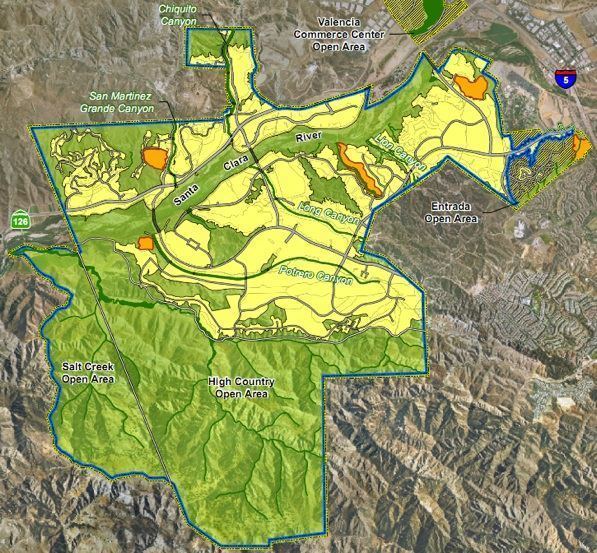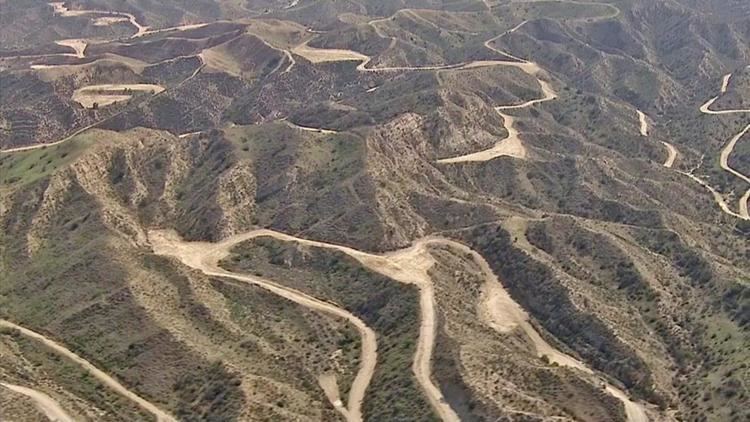 | ||
Newhall Ranch is a proposed large scale master-planned community in an unincorporated portion of Los Angeles County along the Santa Clara River in the westerly portion of the Santa Clarita Valley. The development was conceived in the 1980s by Newhall Land, a land management company which created for the master community planning of nearby Valencia in the 1960s. During the decades the project has been in planning, it has faced legal actions, environmental concerns, and several changes in investors. The landmark California Environmental Quality Act, or CEQA, has been used to challenge the development even after it received planning approvals. While these lawsuits have been dismissed as merely tactics to block or delay the project by some, others claim the environmental law has led to a better-designed project while saving crucial habitat.
Contents

The required permits for the project describe how the work will fill in and alter more than 82 acres (33 ha) of flood plain and tributaries straddling one of the most dynamic river systems in southern California that has provided habitat for a wide array of native plants and animals. These include threatened and endangered fauna and flora, including the California condor, the California gnatcatcher, the southwestern willow flycatcher, the least Bell's vireo, the arroyo toad, the San Fernando Valley spineflower, and the threespine stickleback. The area has historically supplied humans with water, fish, and fertile farmland.

Project description

The proposed development would build 20,885 homes, a commercial district, water reclamation plant, seven public schools, three fire stations, a regional park, three community parks, a golf course, and a 15-acre (6.1 ha) lake. 6,000 acres (2,400 ha) of permanent open space would be set aside and 50 miles (80 km) of trails developed. Developers would also convert nearly 20 miles (32 km) of tributaries and riverbank into storm drains and levees and use 20,000,000 cubic yards (15,000,000 m3) of excavated soil to fill in wetlands.

The boundary with Ventura County forms a portion of the westerly line with the Six Flags Magic Mountain theme park and Stevenson Ranch on the east along with the City of Santa Clarita, which has been strongly opposed to the project. Santa Clarita was formed in 1987 from four unincorporated communities (Valencia along with Saugus, Newhall, and Canyon Country).
The water reclamation plant serving the development will be near the boundary with Ventura County. The plant will treat an estimated 6,800,000 US gallons (26,000,000 l; 5,700,000 imp gal) of water every day before releasing it into the Santa Clara River as it flows towards the ocean and into Ventura County. The downstream impact and other effects also drew Ventura County officials and citizens into opposition to the project.
Landmark Village will be the first neighborhood to be built. Mission Village, with 4,000 homes, will have a "downtown style" mixed-use center. Homestead Village and Portero Village are also being planned.
Project status
Newhall Ranch has been in planning for decades, facing legal actions, environmental concerns, and repeated investor changes. The Lennar Corporation, a national home builder now has a 15% stake in the company with five lenders owning the balance. Several lawsuits have been filed in relation to the project over the years by various environmental groups, and Native American tribes. A lawsuit by three environmental groups was settled in 2004. The developers had hoped to break ground by 2012.
In 2014, the California 2nd District Court of Appeal overturned a Los Angeles County Superior Court ruling and found that the environmental impact report adequately analyzed the project's potential impact on endangered fauna and flora and Native American cultural artifacts. The ruling also supported the agency's determination that storm-drain runoff from the project's 2,587 acres (1,047 ha) into the Santa Clara River would not harm juvenile steelhead trout downstream in Ventura County. Subsequently, the California Supreme Court agreed to review a petition that stated the appellate court opinion exempting developers from protections for the unarmored threespine stickleback would apply to other protected species such as the California Condor. Also of concern is that participation in land-use issues is discouraged by requiring that public comments be submitted early in the environmental review process rather than up to the time of project approval.
The environmental review for the Mission Village neighborhood was upheld by a Los Angeles Superior Court in May 2014.
In April 2015, the Appellate court affirmed the environmental review for the Landmark Village neighborhood and approved the commence of the neighborhood's construction. However, there are most likely to be more environmental groups that are against the project to sue over Landmark Village.
The California Supreme Court ruled in November 2015 that Newhall Land Development Inc. failed to provide evidence in its overall Environmental Impact Report (EIR) to prove its project was consistent with state guidelines to control harmful greenhouse gases. In May 2016 the state Supreme Court directed lower courts to toss out the EIRs mentioned above for two phases of Newhall Ranch construction.
